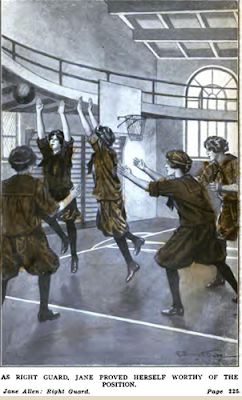This year, Jane Allen is glad to be returning to Wellington College and Madison Hall. However, some spiteful person (I wonder who?) has written ahead to tell Mrs. Weatherbee that she won't be needing her room. By the time Jane arrives, it's been given to an unpleasant freshman, Elsie Noble, who is Marian's cousin. Jane and Mrs. Weatherbee sort it out, but Judy has by then christened Elsie, "the ignoble Noble." The ignoble Noble lives up to her name by circulating a petition among the freshmen to have them refuse Jane and her friends as escorts to the freshman dance. Luckily, the girls find four "poor" girls who are willing to have them. I'd describe them, but they're barely mentioned again, so why bother?
Basketball is even more of an afterthought in this book than the first one. Jane and Adrienne make the team handily, but Judy's place is taken by Marian, who has bribed two of the judges with limo rides and dinners at the Rutherford Inn. However, with Dorothy resigning as judge and the freshman team resigning their positions unless Dorothy's reinstated, Marian is soon forced to tender her own resignation. Jane plays Right Guard, which is supposed to also be a metaphor for her always being on the side of right. Gag.
To retaliate, Marian orchestrates this elaborate plot to implicate Judy as a kleptomaniac, with Norma and Jane covering for Judy. The basis for this is a conversation Marian overhears at the dance, involving Judy somehow taking another girl (who has since left to be married)'s white lace dress. I'd tell you more about it, only we're never really told, and it's quite confusing. In the end, Mrs. Weatherbee's eyes are opened to Marian's true nature, with the assistance of the formerly ignoble Noble, and Marian and Maizie are no longer welcome to return to Madison Hall the following year.
- I was really intrigued by the character of Maizie Gilbert up until the end of this book. She's not motivated by petty emotions like Marian is, and she's not exactly a weak character who just follows Marian's wishes. Instead she's portrayed as almost a lazy sociopath?
- "I don't pretend to understand myself," returned Maizie tranquilly. "It would be too much trouble to try. Besides, self-analysis might be fatal to my comfort. I might dig up a conscience, and that would be a bore. I'd rather take it easy and smile and be a villain still. Changes are so disagreeable. You'd find that out, if one came over me. You'd be minus a valuable ally." See? There's self-awareness there, but no real conscience.
- Maizie has "unfathomable" black eyes.
- "It strikes me," drawled Maizie, "that there's been altogether too much of this 'paying back' business. You'd best drop it, Marian. You're not a success in that line." Jane and her friends are too kind to have any truly entertaining criticisms of Marian. Maizie has no such qualms.
- "She's a strange girl, Judy. There's a lot to her beneath that lazy, indifferent manner of hers."
- Of course, in the end, Maizie is converted to Jane Allen's goodness. I, for one, was disappointed.
- The sophomore team has khaki uniforms, as a nod to patriotism. This is the only mention, however oblique of WWI in the series thus far.
- The ebook is available here. Love the illustrations, even if one seems to be missing from this copy. They're by R. Emmett Owen. I haven't seen the first title's illustrations, but they're by Roy L. Williams


















